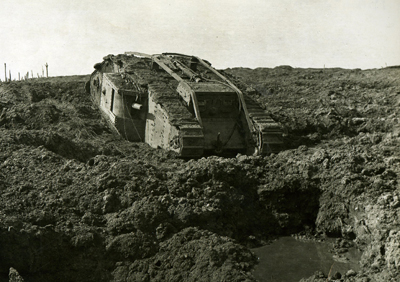Third Ypres was planned as an infantry and artillery attack, with tanks in a supporting role. However they were far from an afterthought, indeed by this time formalised methods of signalling infantry from the tank had been developed, and they would have a part to play.

On the first day, just like at Messines, the British plan didn’t rely on tanks to break through the German defences and very few concessions were made for their needs. In particular the artillery did not leave any unshelled ‘lanes’ for the tanks to advance through. It was considered more important to meet the infantry’s requirement for a creeping barrage to suppress German positions.
It was decided that the most useful role for the tanks was in maintaining the momentum of the attack. After breaking through the German First Line the infantry would need time to consolidate and evacuate casualties before they could hope to continue advancing. This was where the tanks would come into play. One third of the 136 taking part were assigned to destroy German strongpoints in front of their Second Line, and another third to support the advance to the Third Line (the rest were in reserve).
When the attack began on the 31st July the ground was heavily churned up from weeks of shellfire. Conditions were made even worse by the torrential rain that began falling that afternoon, creating a sea of mud. The ground became almost completely impassable, and tank after tank sank in and had to be abandoned. In the end only 19 were able to play any part in attacking the German Second Line, 77 ditched or broke down and 42 had to be completely written off.
Stuck in the Mud

As early as the 2nd August Tank Corps commanders were recommending the tanks should be withdrawn as they couldn’t accomplish anything in the conditions, an opinion shared by the General in command of the attack, Hubert Gough.
It was around this time that the reputation of the Tanks Corps reached its lowest point. In a report Gough concluded that tanks struggled on poor ground, and as the ground on a battlefield would most likely always be poor, they had no real place. Additionally, he considered that after almost a year whatever morale effect they had ever had on the Germans was gone.

Even on good ground tanks were mechanically unreliable and conditions for the crew limited their endurance to only a few hours. On top of all this the Army was suffering from a shortage of manpower, so plans to continue expanding the Corps appeared unrealistic, and there was even a danger it might be reduced or disbanded altogether.
Importantly, although he accepted their achievements had been modest, the Tank Corps retained the support of the British commander in France, Douglas Haig.
Third Ypres continued until the 20th November, but the tanks played a very limited role, being committed on just 10 days and in numbers ranging from 34 to only 4. Perhaps the most successful of these small scale operations took place on the 19th August.
The Cockroft

Eight tanks from G Battalion were assigned to support infantry in attacking three German strongpoints near St Julien. To minimise the risk of ditching they advanced along what remained of the roads rather than going across country.
Once each tank reached its assigned strongpoint, the crew simply fired on it until the defenders gave up then signalled the infantry to move forward. The attack was exceptionally successful, although on a very small scale. Even here though, 4 of the tanks ended up ditched.
The Tank Corps made much of this victory, and after the war there were suggestions that it had helped save the Corps. German records, on the other hand, barely mentioned it.
In subsequent operations luck and the weather increasingly determined success or failure, and by early October it was clear that the worsening conditions meant that the use of tanks was no longer viable. They were withdrawn.
Lessons for the Tank Corps
Tank Corps commanders learned from their experience at Ypres. They knew that tanks would be best used on ground that hadn’t been churned up by artillery and began to plan attacks on this basis. By the autumn of 1917 advances in artillery techniques meant it was now possible to accurately fire on targets without the need for lengthy bombardments.
These two developments would come together in November at the Battle of Cambrai.
Read more about the battle itself here, Operation Hush here and the planning and background here.





